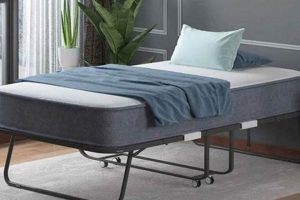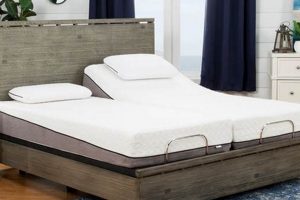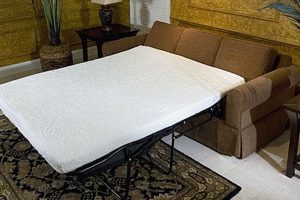An inflatable sleeping surface designed specifically for the cargo area of a pickup truck provides a mobile and adaptable solution for temporary rest. This product typically conforms to the dimensions of the truck bed, utilizing the wheel wells and side rails as structural supports. The result is a relatively level and comfortable platform for sleeping, suitable for camping, road trips, or spontaneous overnight stays. As an example, a standard full-size truck bed could accommodate an air mattress engineered to fit snugly within its confines.
The advantages of such a sleeping arrangement are multi-faceted. It offers a readily available and private sleeping space, reducing reliance on formal accommodations. This increases flexibility in travel planning and lowers accommodation expenses. Historically, simpler bedding solutions have been employed in truck beds, but modern inflatable mattresses provide enhanced comfort and convenience due to their portability and ease of inflation. The ability to quickly deploy a sleeping area in a truck bed can be particularly valuable in situations where pre-arranged lodging is unavailable or undesirable.
The subsequent discussion will delve into various aspects of these truck-bed-compatible air mattresses, including the materials used in their construction, the different inflation methods available, considerations for safety and durability, and advice for selecting the most suitable model for specific needs and truck configurations.
Tips for Selecting and Using a Truck Bed Blow Up Mattress
Selecting and utilizing an inflatable mattress intended for use in a pickup truck bed requires careful consideration to ensure both comfort and safety. The following guidelines offer a practical approach to maximizing the benefits of this mobile sleeping solution.
Tip 1: Measure the Truck Bed Dimensions: Accurate measurements of the truck bed’s length, width (between the wheel wells), and depth are essential before purchasing an air mattress. Mismatched dimensions will compromise the fit and potentially lead to discomfort or instability.
Tip 2: Consider Material Durability: Opt for mattresses constructed from heavy-duty PVC or reinforced nylon. These materials offer greater resistance to punctures and abrasions, particularly important when used in the potentially rough environment of a truck bed.
Tip 3: Evaluate Inflation Methods: Electric pumps provide rapid inflation, while manual pumps offer a backup option in areas without access to electricity. Select a mattress with a pump that aligns with anticipated usage scenarios. Some mattresses have built-in pumps for convenience.
Tip 4: Prioritize Comfort Features: Look for mattresses with integrated pillow rests or flocked surfaces. These features enhance comfort and prevent sleeping bags from sliding during the night.
Tip 5: Secure the Mattress Within the Truck Bed: Use tie-down straps or cargo nets to secure the inflated mattress to the truck bed’s anchor points. This prevents shifting during transit or potential displacement in windy conditions.
Tip 6: Protect the Truck Bed Surface: Place a protective liner or padding underneath the mattress to prevent abrasion of both the mattress and the truck bed’s paint or finish. A simple tarp or a custom-fit truck bed mat can serve this purpose.
Tip 7: Check for Air Leaks Regularly: Inspect the mattress for leaks before each use. Address any leaks promptly with a patching kit to maintain consistent inflation throughout the night.
Adhering to these recommendations will contribute to a safer and more comfortable experience when using an inflatable mattress in a truck bed, maximizing its utility as a mobile sleeping solution.
The subsequent sections will explore specific models and brands, providing a comparative analysis to aid in the final selection process.
1. Dimensions and Fit
The proper dimensions and secure fit are paramount to the functionality of a truck bed blow up mattress. The truck bed is not a uniformly shaped space; wheel wells intrude, and the bed’s length and width vary across different truck models. An inaccurately sized inflatable mattress will either fail to fully utilize the available space, resulting in an unstable sleeping surface, or it will be too large, leading to difficulty in inflation and potential damage to the mattress itself. A mattress that is too short, for example, leaves an unusable gap, while one that is too wide may buckle against the truck bed’s sides, causing uneven support.
Manufacturers address this dimensional variability by offering mattresses designed for specific truck bed sizes short bed, standard bed, long bed and sometimes even for specific truck makes and models. Some designs incorporate cutouts or contours to accommodate wheel wells, maximizing the usable sleeping area. Failure to account for these nuances can lead to discomfort, reduced sleeping space, and accelerated wear on the mattress due to improper support. For example, a mattress intended for a short bed truck will not adequately fill a long bed, creating unsafe gaps.
In summary, the relationship between dimensions and fit is not merely about physical compatibility, but rather the core determinant of utility and safety. Selecting an air mattress engineered specifically for the target truck bed dimensions ensures a stable, comfortable, and durable sleeping arrangement, avoiding the compromises and potential hazards associated with an ill-fitting product. The consequences of neglecting this critical aspect can range from a restless night to potential damage to the mattress itself, underscoring the importance of accurate measurement and informed purchasing decisions.
2. Material Durability
Material durability is a critical determinant of the lifespan and performance of a truck bed blow up mattress. The conditions within a truck bed are inherently demanding, exposing the mattress to potential abrasion from the bed’s surface, punctures from cargo or debris, and temperature fluctuations that can weaken materials over time. Consequently, the material composition directly influences the mattress’s ability to withstand these stresses and provide reliable support. For example, a mattress constructed from thin, non-reinforced PVC is significantly more susceptible to punctures and air leaks compared to one made from thicker, multi-layered PVC with embedded fibers. The choice of material thus dictates the frequency of replacements and the overall cost of ownership.
The selection of durable materials also affects the mattress’s ability to maintain its shape and firmness over extended periods. Repeated inflation and deflation cycles, coupled with the weight of occupants, place considerable stress on the seams and material integrity. A poorly constructed mattress will exhibit stretching, bulging, or seam failures, compromising its ability to provid
e a level and comfortable sleeping surface. In practical terms, a mattress utilizing reinforced nylon or TPU (thermoplastic polyurethane) will generally demonstrate superior resistance to these degradation effects compared to standard vinyl, resulting in improved long-term performance and user satisfaction. Further, the presence of UV-resistant coatings on the material can mitigate the damaging effects of sunlight exposure, particularly when the truck bed is uncovered.
In conclusion, the material durability of a truck bed blow up mattress is not merely a superficial attribute but a fundamental factor governing its utility and longevity. Selecting a mattress constructed from robust, puncture-resistant, and UV-stable materials is essential for ensuring a reliable and comfortable sleeping solution that can withstand the demanding environment of a truck bed. The initial investment in a higher-quality, more durable mattress will often translate into significant cost savings and improved performance over the lifespan of the product. The challenge lies in discerning the material composition and construction quality, as these factors are not always readily apparent in product descriptions, necessitating careful research and consideration of user reviews.
3. Inflation System
The inflation system of a truck bed blow up mattress represents a critical component that directly influences its practicality and ease of use. The efficacy and convenience of the system determine how quickly and effortlessly the mattress can be prepared for use in diverse settings. This aspect is particularly relevant in the context of mobile applications, where access to reliable power sources may be limited, and rapid setup is often desirable.
- Integrated Electric Pumps
Many models feature integrated electric pumps, powered by either a 12V DC adapter suitable for a vehicle’s cigarette lighter socket or a standard AC power cord. These pumps offer automated inflation, significantly reducing the physical effort required. The convenience of an integrated pump is especially valuable in situations where manual inflation would be cumbersome or time-consuming. However, reliance on an electric pump necessitates access to a functioning power source, potentially limiting usability in remote locations.
- External Electric Pumps
External electric pumps provide an alternative to integrated units, offering increased flexibility. These pumps, often compact and portable, can be powered by various sources, including vehicle outlets, portable power stations, or even battery packs. The separation of the pump from the mattress allows for easier maintenance and replacement if the pump fails. Furthermore, some external pumps offer additional functionalities, such as deflation capabilities, streamlining the packing-up process. However, the need to manage a separate pump adds to the overall setup complexity and necessitates ensuring compatibility with the mattress’s valve system.
- Manual Inflation Options
Manual inflation systems, typically involving foot pumps or hand pumps, provide a backup solution in situations where electric power is unavailable. While requiring more physical exertion, manual pumps offer a reliable means of inflating the mattress regardless of location. These systems are often more compact and lightweight than electric pumps, making them suitable for backpacking or camping scenarios where minimizing weight and bulk is paramount. The inflation process is, however, considerably slower and more labor-intensive, potentially diminishing the appeal for users prioritizing convenience.
- Valve Design and Compatibility
The design of the inflation valve and its compatibility with various pump types is a crucial consideration. Valves should be robust, leak-proof, and easily accessible. Some mattresses employ specialized valve systems that require specific pump attachments, while others utilize more universal designs compatible with a wider range of inflation devices. The valve’s ease of use and reliability directly impact the speed and efficiency of the inflation process. A poorly designed valve can lead to air leaks, difficulties in attaching pumps, and overall frustration during setup.
The selection of an appropriate inflation system for a truck bed blow up mattress hinges on the intended usage scenario, available resources, and user preferences. Factors such as accessibility to power outlets, physical capabilities, and desired level of convenience all play a role in determining the optimal choice. The interplay between the inflation system’s features and the specific demands of the application underscores its importance in ensuring a positive and practical user experience. Neglecting to consider the inflation system can lead to difficulties in setting up the mattress, diminishing its utility as a mobile sleeping solution.
4. Comfort Level
The comfort level associated with a truck bed blow up mattress is a primary determinant of its practicality and user satisfaction. The objective is to transform a utilitarian truck bed into a reasonable facsimile of a conventional sleeping environment, mitigating the inherent discomforts associated with sleeping in a vehicle. Factors contributing to comfort extend beyond simple inflation and involve a complex interplay of material properties, design features, and user-adjustable parameters.
- Surface Texture and Material
The tactile quality of the mattress surface significantly impacts perceived comfort. Smooth, bare PVC can feel cold and clammy, especially in varying temperatures. Flocked surfaces, typically employing short fibers bonded to the PVC, provide a softer, warmer touch and reduce the tendency for sleeping bags or bedding to slide. For example, a mattress with a plush, microfiber-like surface offers a significantly more comfortable sleeping experience than one with a simple, non-treated PVC surface. The choice of material and surface texture directly correlates with the overall sense of comfort and warmth.
- Internal Support Structure
The internal architecture of an air mattress influences its ability to distribute weight evenly and minimize sagging or pressure points. Basic air mattresses consist of a single air chamber, which can result in uneven support and discomfort, particularly for heavier individuals. More advanced designs incorporate internal baffles, coils, or I-beam constructions to create a more stable and supportive sleeping surface. An example is a mattress with vertical I-beams, which prevent the mattress from bulging in the middle when weight is applied. The complexity and effectiveness of the internal support structure directly impact the degree of comfort and support provided.
- Inflation Pressure and Adjustability
The ability to adjust the inflation pressure allows users to fine-tune the firmness of the mattress to their individual preferences. A mattress inflated to maximum pressure may feel too firm for some, while a mattress with insufficient inflation may sag excessively. Models with adjustable valves and pressure gauges enable users to achieve the optimal balance between support and cushioning. An example is a mattress with a two-way valve, allowing precise adjustments to inflation levels. The capacity for individual adjustability is crucial in accommodating diverse sleeping styles and weight ranges.
Insulation Properties In colder climates or seasons, the lack of insulation in a standard air mattress can lead to significant heat loss, resulting in discomfort and potential hypothermia. Air mattresses lack inherent thermal resistance, allowing heat to dissipate rapidly. Some models incorporate insulating layers or materials to mitigate this effect. An example is a mattress with a layer of closed-cell foam or reflective material, which reduces heat transfer. The presence of insulation properties is especially relevant for users planning to use the mattress in colder environments.
The comfort level of a truck bed blow up mattress is not a monolithic attribute, but rather a composite of several interacting factors. Surface texture, internal support, inflation adjustability, and insulation properties all contribute to the overall sleeping experience. Optimizing these elements transforms the inherently uncomfortable environment of a truck bed into a more habitable and restful space. Consequently, careful consideration of these factors is paramount when selecting a mattress to ensure that it meets individual comfort requirements and environmental conditions. Further improvements may include adding a mattress topper or using high-quality bedding to augment comfort.
5. Storage and Portability
Storage and portability represent crucial determinants of the practicality and overall utility of a truck bed blow up mattress. The inherent nature of a truck bed air mattress implies intermittent use, necessitating efficient storage solutions when the mattress is not deployed. Similarly, its intended application for mobile sleeping demands a level of portability that facilitates convenient transportation to and from the vehicle. The ease with which the mattress can be stored and transported directly impacts its real-world usability, influencing decisions regarding its suitability for specific travel or recreational scenarios. For instance, a bulky and difficult-to-fold mattress might deter spontaneous camping trips, whereas a compact and lightweight option encourages greater utilization.
The design of a truck bed air mattress significantly influences its storage and portability characteristics. Materials chosen for construction, inflation valve mechanisms, and the inclusion of integrated storage bags all contribute to the overall packed size and weight. Mattresses employing thicker, more durable PVC might offer enhanced puncture resistance but often result in a larger and heavier packed form. Conversely, mattresses utilizing lighter-weight fabrics may compromise durability in favor of reduced size and weight. Folding and deflation mechanisms also play a role; mattresses with multiple air chambers and strategically placed valves can be deflated and folded more compactly than simpler, single-chamber designs. Consider, for example, a mattress with a built-in electric pump and a tightly integrated storage bag versus one lacking these features; the former typically presents a more streamlined and manageable storage solution. Practical applications extend to situations where limited cargo space necessitates prioritizing compact and lightweight gear, rendering storage and portability paramount.
In conclusion, storage and portability are inextricably linked to the functional value of a truck bed blow up mattress. These considerations transcend mere convenience, impacting the frequency of use and the suitability of the mattress for various travel scenarios. The challenge lies in striking a balance between durability, comfort, and ease of storage, requiring consumers to carefully evaluate the trade-offs inherent in different designs and material choices. Ultimately, a truck bed air mattress that is both comfortable and conveniently portable maximizes its potential as a versatile and practical mobile sleeping solution.
Frequently Asked Questions
The following questions address common inquiries and concerns regarding inflatable mattresses designed for use in pickup truck beds, providing concise and informative responses.
Question 1: What are the primary advantages of using an inflatable mattress in a truck bed instead of alternative sleeping arrangements?
An inflatable mattress offers a readily available, comfortable, and private sleeping space within the confines of a pickup truck bed. This eliminates reliance on potentially costly or unavailable lodging options during travel or outdoor activities. The mattress can be quickly inflated and deflated, providing a flexible sleeping solution without requiring extensive setup or permanent modifications to the vehicle.
Question 2: How does one ensure the correct size and fit of an inflatable mattress for a specific truck bed model?
Accurate measurements of the truck bed’s length, width between wheel wells, and depth are crucial. Consult the mattress manufacturer’s specifications and compare them to the truck bed dimensions. Some manufacturers offer models designed for specific truck makes and bed sizes (short, standard, long) to ensure optimal fit and stability.
Question 3: What materials are commonly used in the construction of truck bed inflatable mattresses, and what are their respective benefits?
Heavy-duty PVC and reinforced nylon are common materials. PVC offers durability and water resistance, while reinforced nylon provides increased puncture resistance and tensile strength. Some mattresses incorporate flocked surfaces for enhanced comfort and reduced slippage. Material selection directly impacts the mattress’s lifespan and performance in demanding truck bed environments.
Question 4: What inflation methods are typically available for truck bed inflatable mattresses, and what are the advantages of each?
Inflation methods include integrated electric pumps, external electric pumps, and manual pumps. Electric pumps offer rapid and effortless inflation when a power source is available. Manual pumps provide a reliable backup option in remote locations without electricity. The choice of inflation method depends on the user’s preferences and anticipated usage scenarios.
Question 5: How can one mitigate the risk of punctures or damage to the inflatable mattress while using it in a truck bed?
Placing a protective liner or padding underneath the mattress prevents abrasion from the truck bed surface. Removing any sharp objects or debris from the truck bed prior to inflation is also recommended. Selecting a mattress constructed from puncture-resistant materials, such as reinforced PVC, further reduces the risk of damage.
Question 6: What storage considerations are important when selecting a truck bed inflatable mattress?
Consider the deflated size and weight of the mattress, as well as the ease with which it can be folded and stored. Mattresses with integrated storage bags offer convenient organization and protection during transportation. Compact storage is essential for maximizing available cargo space and facilitating spontaneous use.
In summary, selecting and using a truck bed inflatable mattress involves careful consideration of dimensions, materials, inflation methods, and storage needs. Addressing these factors ensures a comfortable, safe, and practical mobile sleeping solution.
The subsequent section will address the legal implications and safety considerations of sleeping in a truck bed in different jurisdictions.
Conclusion
The preceding exploration of the truck bed blow up mattress underscores its utility as a flexible and
readily deployable sleeping solution for pickup truck owners. The analysis has traversed critical considerations ranging from dimensional compatibility and material durability to inflation systems and storage implications. Proper selection, informed by an understanding of these factors, is paramount to maximizing comfort, safety, and the overall lifespan of the product. The practical applications, extending from recreational camping to emergency overnight stays, highlight the adaptability of this mobile sleeping arrangement.
The continued evolution of truck bed blow up mattress technology and design suggests a future trajectory focused on enhanced durability, improved comfort features, and more efficient storage solutions. Individuals considering the adoption of this sleeping solution are encouraged to prioritize thorough research and careful assessment of their specific needs and vehicle configurations. Such diligence ensures a judicious purchase and promotes responsible utilization of this increasingly popular accessory, ultimately contributing to safer and more comfortable travel experiences.







